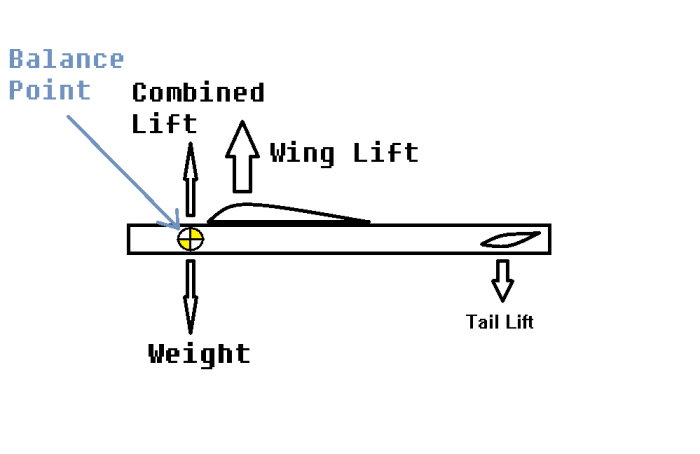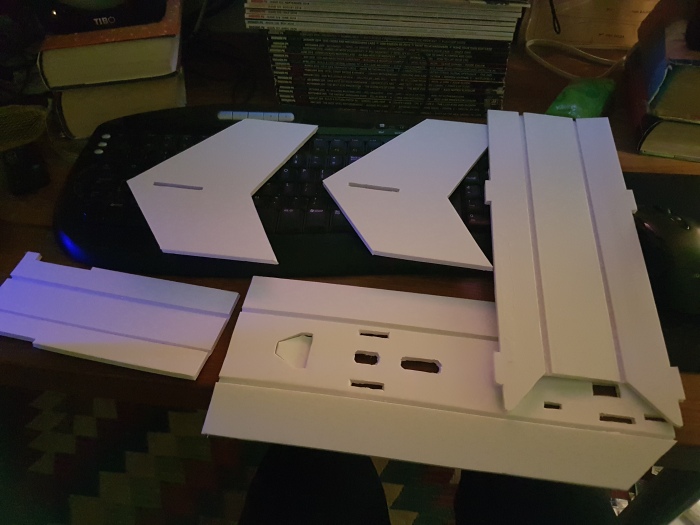And now we actually get the tail bits designed! I totally just realised the last post should have been labelled as tail theory or something. That whole thing kind of ran away with itself. Henceforth, things should be a little more focused.
Thus: forwards, to the bits at the back!
Seesaws, how do they work?
Given the relative simplicity of the design of the fin, we’ll be leaving it aside until we have the tailplane sorted out. Longitudinal stability can be a right pain sometimes, but we can’t fly nothing until we gots it sorted.
Remember from the last post how the tailplane acts as a counterbalance to the wing’s tendency to pitch down? Like a seesaw, there are two key factors in determining how effective that counterbalancing can be: how much brute force the tail can generate, and how far it is away from the balancing point. In the case of an aircraft, the centre of gravity is that balancing point.


Now, calculating exactly how much counterbalancing force the tailplane can generate involves the same long, drawn-out process we used for the wing. This idea bores me, and we have a perfectly good shortcut that will suit us just fine. It basically comes down to this:
- The tailplane is there to work against the pitching-down tendency of the wing
- Logically, you’d think a big wing would need a big tail to compensate
- Instead of calculating the exact downforce generated by the tailplane, why not just slave the size of the tail to the size of the wing?
With this in mind, we’ll be using the nifty formula for the Tail volume coefficient. It basically allows us to take the size of the wing, and use that information to determine how big and how far back our tailplane should be.
Tail Volume Coefficient = (Tailplane Area x Tail Moment) ÷ (Wing Area x Wing Chord)
Tail Moment is the distance of the tailplane’s aerodynamic centre from the aircraft’s centre of gravity. This will come in handy when we start designing the fuselage, but for now will just be a variable to solve.
Breaking Wing Area into its constituent parts, chord and span:
TVC = (Tailplane Area x Tail Moment) ÷ (Wing Span x Wing Chord x Wing Chord)
Or more concisely:
TVC = (Tailplane Area x Tail Moment) ÷ (Wing Span x Wing Chord^2)
Plugging our values for Wing Chord and Wing Span (see Wing Design: Part 4):
TVC = (Tailplane Area x Tail Moment) ÷ (0.27 x 0.27 x 1.5)
Tail Volume Coefficient = (Tailplane Area x Tail Moment) ÷ 0.11
To clarify, I rounded up pretty roughly. We’re only dealing with the initial design here, so we’ll be fine with this.
So we now have three unknowns: Tail Volume Coefficient, Tailplane Area, and Tail Moment. Tail volume coefficients are basically just ratios, so picking within a rough range should give us the answer we need. Too low, and the tailplane won’t have enough authority to overcome the pitching moments from the wing. Too high, and our tailplane will be big, heavy, and will be so stable it will end up fighting us when we actually want to change pitch. Fortunately, there are a whole bunch of books and internet sources with just the range we need, and generally speaking, they say that the Tail Volume Coefficient should range from 0.35-0.45. Since this is only a simple model meant to be flown by pretty much anyone, let’s just go for the middle value, and say:
Tail Volume Coefficient = 0.4
Plugging this back into the formula:
0.4 = (Tailplane Area x Tail Moment) ÷ 0.11
And rearranging:
Tailplane Area x Tail Moment = 0.4 x 0.11
Tailplane Area x Tail Moment = 0.044
Success!

We’re now left with the only two numbers we actually care about.
So… what now? Find out next time on Let’s see. We have two unknowns and a numerical relationship between them. We could do pretty much anything here. For instance: feeling lanky? Let’s throw that tail 2m back. Tail Area will be 0.022m^2. Fancy something more compact? Let’s try 10cm back – Tail Area will be 0.44m^2. The tail closer to the CG is 20 times as large as the one that’s planted way back. In all likelihood, it would also occupy the same space as the wing, which is clearly impossible. I mean, unless your engineering skills are native to Ry’lyeh, in which case… why the hell are you reading this blog?
We’ve established a relationship between Tailplane Area and Tail Moment; if we set one, we also set the other. But which factor do we want to set? And if we can pick any value, where do we even start?
This presents a particularly interesting question: what do you do when you have literally infinite options to choose from? Indeed, taken out of the aircraft design context and applied generally, this question has a dizzyingly-wide swathe of philosophical implications. We are indeed condemned to be free.
If, like me, that statement fills you with existential dread, then fear not!
FREEDOM IS SLAVERY [sort of]
There are a few factors which narrow our options down. A key part of engineering is overcoming challenges with a limited range of approaches.
Consider the following factors in favour of a shorter fuselage with a larger tail:
Structural
- A small tail will require a long fuselage; a long fuselage is a weaker and heavier fuselage which will break easily.
- A smaller tail could be more fragile.
Practical
- Airfoil shapes are not the easiest things in the world to build. Take it from me: small tail surfaces can be a bloody nuisance to shape. Having a larger tail would make it easier to build the tail from constituent pre-shaped parts, making a proper aerofoil shape much easier to create
- A long fuselage could make transporting and storing the model more difficult, as it would take up more space.
- Your control surfaces would be further away from your servos (the bits that move the control surfaces), so you’d need long control cables to connect your servo arms to your control surfaces; this would increase slop and could lead to nasty aerodynamic complications (look up flutter).
- Landings would also be more tricky, as that long fuselage would make tail strikes more likely.
Aerodynamic
- A small tail will reduce the Reynolds numbers of the air flowing over the tail. This tends to reduce performance across the board, though in our situation it isn’t critical.
- A large, close-in tail would be better able to take advantage of propwash, where fast-moving air accelerated by the propellor passes through the area occupied by the tail. This give the elevator and rudder extra bite at low speeds, improving control in a particularly vulnerable area in the flight envelope.
And those in favour of a long fuselage with a short tail:
Structural
- A short fuselage will require a large tail, which will be heavier than a long fuselage and a short tail. This could make balancing the aircraft slightly trickier.
Practical
- Assuming we’re fabricating the model from balsa: if built small enough, tail surfaces can actually be sanded into shape from a single sheet of balsa. A tail which is slightly too large for this will need to be assembled from individual parts, all of which will need sanding to shape. This can be a bloody nuisance.
Aerodynamic
- A large, close-in tail could lead to unexpected aerodynamic interactions which could introduce funky behaviour and reduce efficiency. Fluid dynamics is complicated like that.
There’s probably a heap of factors that I’ve missed, but you get the gist of it.
IGNORANCE IS STRENGTH [well…]
So, odds are we’ll probably want a shorter fuselage with a larger tail. But that still doesn’t really give us any figures to work with.
So! We’ll do what any engineer worth their salt does, and cheat a bit. Cue internet.
General searching reveals a commonly-accepted figure: that the Tail Area is usually 15-20% of the wing area. Let’s go large and settle on 20% – this is a trainer after all, and we’ll want the extra stability.
Tail Area = Wing Area x 0.2 –> Tail Area = Wing Span x Wing Chord x 0.2
Tail Area = 1.5 x 0.27 x 0.2
Tail Area = 0.081m^2
Tailplane Area x Tail Moment = 0.044 –> Tail Moment = 0.044 ÷ Tail Area
Tail Moment = 0.044 ÷ 0.081
Tail Moment = 0.54m
WOO!
Now, the Tail Moment figure will come into its own later. For now, we’ll get along with setting the shape of the tailplane – which pretty much comes down to setting an aspect ratio and running with it. Cue internet again.
K, so it looks like the norm is 4-5. Since a square tail is a stronger tail, let’s go low and aim for 4. It won’t be as efficient, but it will be more likely to survive the tougher knocks of life. Since the tailplane chord is increased as a result, we also get a bit of a boost to Reynolds flow, which is always handy.
Tail Aspect Ratio = 4
Tail Aspect Ratio = Tail Span ÷ Tail Chord –> Tail Span ÷ Tail Chord = 4
Since we have two unknowns, this isn’t of much use to us. However, with some mathematical poking:
Tail Span = 4 x Tail Chord
We’ve made one of the unknowns a function of the other. Recalling our Tail Area:
Tail Area = Tail Chord x Tail Span = 0.081
We just plug our former formula into our latter one:
Tail Chord x (4 x Tail Chord) = 0.081
Cleaning this up:
Tail Chord^2 = 0.020
So therefore:
Tail Chord = √0.020
Tail Chord = 0.14m
And plugging this back into our rearranged aspect ratio formula:
Tail Span = 4 x Wing Chord = 4 x 0.14
Tail Span = 0.56m
So now we know:
- How big the taiplane is going to be
- Where it’s going to sit vs the CG (not much use to us right now, but will come in handy later)
- What shape the tailplane is going to be
To complete the empennage design, we need to figure out:
- How tall our fin is going to be (we’ll just slave fin chord to tailplane chord for the sake of simplicity)
- What aerofoils we’ll be giving our tail surfaces
WAR IS PEA- hang on…
I have just picked this post up after… what, a month? Three? I’ve actually starting building a new plane out of foamboard in the interlude. Progress has been stymied by the fact that my foamboard sheet is too small to build the wing with. Also laziness.

What else? Unexpected change in circumstances. Very exciting. Yes. Much disruption. Would have thrown fin design in here, but then the post wouldn’t have gotten out for another few months while I procrastinated about the size of this post.
More posts in future. When? The future. I have sort of exhausted the word “soon”.
Oh yeah, one last thing – it’s past midnight and I couldn’t quite be bothered to do my usual thing of multiple re-reads with a fine-toothed eyeball. Mistakes may come back to bite, but things look pretty ok. There’s an age-old rule of thumb with flying: “If it looks right, it’ll fly right”. This won’t help with bad CG placement (believe me, I know), but in these initial stages, we can afford to be a bit loose.
Until next time. In the future. By which time this post will be in the past. Spooky.